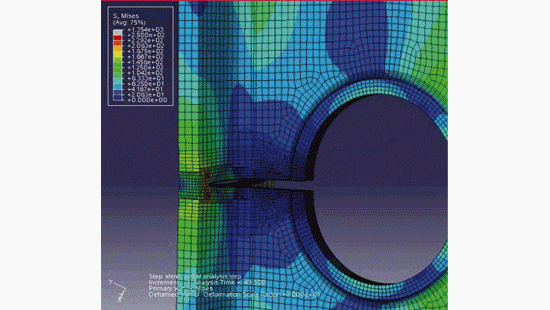
Fracture Mechanics and the eXtended Finite Element Method
Transportation safety, including for example, aircraft, ships, and bridges, depend upon having some reliable estimation of their mean time to failure. One important failure mechanism is in the degradation of metal components that go through repeated stresses during their normal usage. For example, when a small crack appears in a large metal bridge, it’s critical to know how long it will take before the crack grows large enough to represent a risk of failure. Therefore, accurate assessment of how many stress cycles a part can reasonably withstand before it fails is essential to maintaining safety, and to achieve that assessment, computational tools are continually being developed to better predict crack growth and when that growth can lead to catastrophic failure.
The Chopp group has been involved in developing some of the first fully three-dimensional fatigue crack growth algorithms, which utilize a combination of the Level Set Method to represent the crack shape and tip location, and the eXtended Finite Element Method for computing the mechanical stresses and determining the direction and rate of growth of the crack tip. These algorithms have been adapted into commercial software, such as the popular Abaqus package, to make these tools available to the engineering community at large.
Below is a list of publications related to this work.
Fatigue Crack Publications
Fracture Articles
| Author(s) | Title/Journal | Year |
|---|---|---|
| A. Sadeghirad, D. L. Chopp, X. Ren, E. Fang, J. Lua | A Novel Hybrid Approach for Level Set Characterization and Tracking of Non-Planar 3D Cracks in the Extended Finite Element Method, Engineering Fracture Mechanics, 160:1-14 | 2016 |
| J. Shi, D. L. Chopp, J. Lua, N. Sukumar, and T. Belytschko | Abaqus Implementation of Extended Finite Element Method Using a Level Set Representation for Three-Dimensional Fatigue Crack Growth and LIfe Predictions, Engineering Fracture Mechanics, 77(14):2840-2863 | 2010 |
| N. Sukumar, D. L. Chopp, E. Béchet, N. Möes | Three-dimensional non-planar crack growth by a coupled extended finite element and fast marching method, International Journal of Numerical Methods in Engineering, 76(5):727-748 | 2008 |
| M. Stolarska and D. L. Chopp | Modeling spiral cracking due to thermal cycling in integrated circuits. International Journal of Numerical Methods in Engineering, 41(20):2381-2410 | 2003 |
| D. L. Chopp and N. Sukumar | Fatigue crack propagation of multiple coplanar cracks with the coupled extended finite element/fast marching method. International Journal of Engineering Science, 41(8):845-869 | 2003 |
| N. Sukumar, D. L. Chopp, and B. Moran | Extended finite element for three-dimensional fatigue crack propagation, Engineering Fracture Mechanics, 70(1):29-48 | 2003 |
| M. Stolarska, D. L. Chopp, N. Möes, and T. Belytschko | Modelling crack growth by level sets in the extended finite element method, International Journal for Numerical Methods in Engineering, 51(8):943-960 | 2001 |
| N. Sukumar, D. L. Chopp, N. Möes, and T. Belytschko | Modelling holes and inclusions by level sets in the extended finite element method. Computer Methods in Applied Mechanics and Engineering, 190(46-47):6183-6200 | 2001 |
